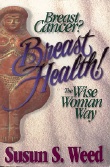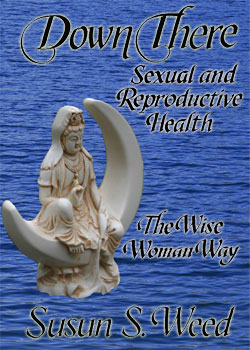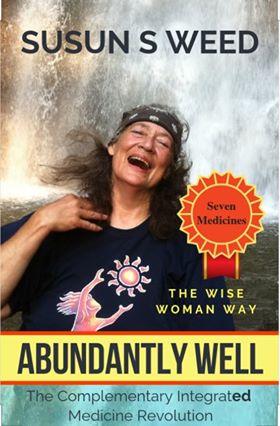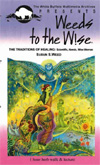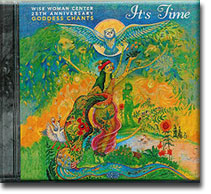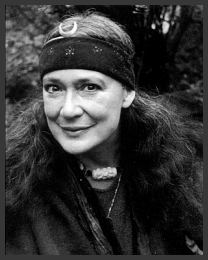THE SHAMANIC HERBALIST
by Susun S. Weed
You Are Invited to Be Part of the Shamanic Herbalists/Healers Association (SHA)SHA is an invisible association. There are no board meetings, no dues, no membership drive, no fund raising. This association is a figment of our imaginations. As such, it is always changing.
The purpose of this association is to define the characteristics of the shamanic (aka, wise woman) herbalist/healer and, by doing so, to claim a space which cannot be defined and limited by law or licensing bodies.
I'M AGAINST LICENSING HERBALISTS
Ever since I went to my first herbalist's gathering two decades ago, there has been one topic guaranteed to elicit raised voices: Shall herbalists be licensed? My position has always been an unequivocal "NO!" I believe that shamanic healer/herbalists especially have everything to lose and nothing to gain from being licensed, accredited, tested, or certified in any manner whatsoever.
Before we go on to the things we can do to keep our "profession" vital and on the beauty way, I would like to share a little of my life with you - a few of the experiences that have shaped the way I think about healing, healers, herbs, and shamans.
WHAT MIDWIVES CAN TELL US ABOUT LICENSINGMy sister and many of my friends are, or were, midwives. Some are certified nurse midwives, some lay midwives, all are well-trained, experienced, skilled, and wise. Barely ten percent of them are working as midwives. Most are disgruntled, discouraged, and depressed about their ability to offer real individualized care to their clients. They sought to license and police themselves, for fear that outside forces would do it if they didn't. And they licensed themselves into oblivion. Rather than ensuring the freedom to help women give birth, midwives find themselves now bound with laws, rules, regulations, protocols, fear of losing one's license, and insurance demands.
I TRUST THE CHAOS OF THE UNIVERSE
In order to issue a license, one must quantify, score a test, determine the measure of a human's knowledge and wisdom, define, lay out the rules, say how it should be. But birth doesn't follow rules. Neither does life. Nor healing. Nor do herbs.
Herbs can change their constituents dramatically in response to being grazed, overgrazed, attacked by insects or molds, experiencing drought or flood, suffering from lack of nutrients, poisoned by too much, or a host of other variables. The scientific drive to quantify active ingredients in herbs creates herbal products that are as dangerous as drugs. I am an herbalist because I believe nature's infinite variety, expressed in the herbs, offers more health/wholeness/holiness than the standardized, sanitized remedies of orthodox medicine.
WHAT CAN WE DO?
How can we continue to practice as shamanic herbalists/healers, as wise women, in the face of pressures to mainstream, certify, and license alternative medicine and its practitioners?
I propose that we define ourselves. That we make ourselves visible in words and thereby declare clearly the impossibility, illegality (according to cosmic law), and absurdity of trying to license shamanic herbalists/healers. Let us present ourselves to ourselves, each other, and our communities - as we have always done, through story, song, dance, and drama, and now through defining words - so that the weave of everyone's reality is touched by a shamanic thread, and our work is kept safe from restriction by the language of law.
Though it is a daunting task, it is necessary to undertake it and possible to do it. What are the characteristics of the shamanic healer? What ought a shamanic healer not do? I envision a discussion that takes place in person, in print, on the Web, by letters, and in the dreamtime.
Here's my list of the characteristics of shamanic herbalists/healers. It isn't meant to be definitive, but to spark discussion. I hope it will be copied, circulated, changed. Comments to Weed, PO Box 64, Woodstock, NY 12498 or www.susunweed.com.1. Shamanic healers and herbalists answer solely to the universal "way” as their authority and as such cannot be restricted by the language of men's law, for such language constitutes an unfair restriction upon the practices, livelihood and life of the shamanic healer.
2. Shamanic healers and herbalists work without regard for payment, but absolutely insist on being honored for the work they do. Any healer who withholds treatment until payment is made is guilty of blackmail and is not to be considered a shamanic healer.
3. Shamanic healers and herbalists use the plant and animal resources of their locality as their healing allies. These resources are harvested in a way that sustains or builds their abundance and diversity. The plants and animals are accorded power, dignity, and sentience. They are addressed directly, prayed to, and usually thanked ritually as well as actually.
4. Shamanic healers and herbalists frequently use power plants in their work. Power plants include indigenous natural (not synthetic) psychoactives such as psilocybin, tobacco, datura, peyote, marijuana, coco leaves, and the like. Trafficking in such plants is not typical of the shamanic healer, who may, nonetheless, supply apprentices with these plants for the purposes of their studies, and keep a personal supply of up to two year's worth of such power plants. These practices are not to be infringed upon by the language or intent of man's law, as such restrictions unfairly prevent the shamanic healer from accessing certain kinds of information.
5. Shamanic healers and herbalists may be very limited in their ability to read, write, figure sums, or otherwise function in the modern world. To try to conceive of a written test which could give any information which would be of use in determining the worth of a shamanic herbalist/healer is to enter the realm of the absurd.
6. Shamanic healers may also be quite limited in their understanding of anatomy, physiology, chemistry, and other modern medical necessities. Nonetheless, each shamanic healer has a "story" about the nature of the world(s) s/he inhabits, and a vision of the health/wholeness toward which the individual patient is moving.
7. Shamanic healers frequently use drama to potentize healing. Community enactments, melodic messages, rhythmic movements, colorful visions, memorable aromas, and more are interwoven in the work of shamanic healers and herbalists. Expect the unexpected here, the unique, the gift of the moment.
8. Shamanic healers respect the power of kundalini/life force and therefore do not engage in sexual release with their patients/clients. This is not to say that shamanic healers and herbalists do not flirt! On the contrary, they are often very raunchy, suggestive, and lewd. But they never cross the line from loving, healing touch to frank sexual need/exchange. Anyone who implies or suggests that their healing power can be best accessed through sexual connection is not a shamanic healer.
9. Shamanic healers support and direct the processes which are common to all of us - birth, initiation, and death - in ways that are unique to the culture and the individual, but which are always characterized, in true shamanic healing, by the intention to honor the person involved and to increase the person's self-confidence and self-acceptance.
10. Shamanic healers are passionate and compassionate. They move easily into joy, anger, and grief, knowing that all feelings can be healers and liberators. Shamanic healers know few fears. They approach life and healing as a cosmic joke, always ready to laugh first at themselves.
11. Shamanic healers don't claim to have the answer or know the answer or be the answer; they remind us that the answer lies within ourselves.
WHAT'S SCIENCE GOT TO DO WITH IT?
Once upon a time, healing was considered an art. Healing was understood by all to be a complex interaction between the patient, the healer, the community of living people, the communities of the plants and animals (and insects and rocks and fish), the communities of the non-living people (such as ancestors, spirit guides, and archetypes) and that mysterious movement known by so many names: Creator, God/dess, All High.
The healing arts included a keen knowledge of human behavior, a thorough knowledge of plants, a flair for the dramatic arts, especially singing/chanting and costuming/body painting, and a comprehensive knowledge of anatomy, physiology, and biochemistry. (If you think these areas are not arts, look at the system used by Traditional Chinese Practitioners, which includes such "organs" as the triple heater and a dozen different pulses.)
Art does not preclude or oppose science. Science is, after all, only the honest testing of ideas and the ability to observe clearly the confusing relationship of cause and effect. The best of science is deeply indebted to art. Art understands that science is left-brained and art is right-brained, and a whole brain includes both.
Science, however, is not so easy with art. Science believes art is superstition. Science believes art is fuzzy, soft, not-replicable, and therefore untrustworthy. (It is interesting to me that the Liberal Arts University I attended - UCLA - required students to take a variety of science courses, but the Science College I turned down - MIT - did not require students to study the arts.) Science defines itself as factual and art as fantastical.
Truly great scientists understand the need to honor intuition along with information. But the world is rarely run by the truly great. So bit by bit, the art of healing is denigrated and the science of healing is venerated. The healer spends more and more time interacting with machines and drugs and technology and less and less time with the patient; more and more time studying books and less and less time learning about the strange, symbolic, provocative powers of the psyche. The healer focuses more and more on fixing the sick individual and less and less on the patient's need for wholeness in self, family, and community.
The herbalist becomes a biochemist. The pharmacist no longer needs to know botany. Herbs are presented as drugs in green coats. And the active ingredient is the only one worth mentioning.
Is this what I want? Is this what drew me to herbs? Is this what fascinates me about herbal medicine? My answer to all these questions is absolutely NOT. While acknowledging the usefulness of science, I maintain the right-brain's superior abilities in the art of healing. I defend the rights of the miracle-workers, the shamans, the witch doctors, the old-wife herbalists, the wise women, those who have the skill, the personal power, and the courage to midwife the changes - large and small, from birth to death and in between - in the lives of those around them.
Herbal medicine. Magical plants. Psycho-active plants. There is a thread here, and it goes a long way back. At least 40,000 years. The plants say they spoke with us all until recently. Forty thousand years ago we know our ancestors were genetically manipulating, hybridizing, and crossbreeding specific psychedelic plants. And using them in healing. Maria Sabina, one of the 20th Century's most renowned shamanic healers, went into the forest as a small child and ate psilocybin mushrooms because they spoke to her. She healed only with the aid of the "little people" (mushrooms) and she healed not just body but soul. In the Amazon, the students of herbalism, of healing, are apprenticed to psychoactive plants as well as to human teachers.
There is a lot of talk lately about the active ingredients in plants. I've had many a chuckle as product ads claim to have the most of this or that only to be superseded by the announcement that a new, better, more active active ingredient has been found.For example, when Kyolic Garlic was shown by Consumer Reports to have virtually no allicin (the "active" ingredient), Kyolic countered with an ad campaign claiming superiority because it contained a different, stronger, active ingredient.
For instance, most standardized St. John's/Joan's wort tinctures are standardized for hypericin. But the latest research shows that hyperforin is the real active ingredient!
To illustrate: an article several years ago in JAMA on use of Ginkgo biloba to counter dementia explained that no active ingredient from among the several hundred constituents present had been determined and it was, in fact, likely that the effect resulted from a complex, synergistic interplay of the parts. An article in the New York Times, however, cautioned readers not to use ginkgo until an active ingredient had been established.
It happened to me: An MD on a menopause panel with me told the audience that no herb was safe to use unless its active ingredient was measured and standardized. What can I say? To me the active ingredient of a plant is the very part that cannot be measured: the energy, the life force, the chi, the fairy of the plant, not a "poisonous" constituent. To the healer/artist/herbalist, the active part of the plant is that part that can be used by the right brain to actively, chaotically, naturally, "jump the octave" and work a miracle. This active part is refined away in standardized products, for the real active part is the messy part, the changeable part, the subtle part, the invisible part.
Does science have anything to do with it? Certainly. The process of identifying specific compounds in plants, replicating them in the laboratory and mass-producing them as drugs cannot be replicated by or superseded by any healer or herbalist. Preparation of standardized drugs protects the consumer (usually) and protects the plants from over harvesting (although the net effect on the environment may be detrimental).
If we put into the lap of science anything having to do with measuring and certifying, then surely I beg science to be the guardian of the purity of the herbs we trade in our commerce, knowing that art is the guardian of the purity of the herbs we gather ourselves. (A tip from the apprentice book: When harvesting, put only one kind of plant in a basket. This allows one to quickly and easily notice if an interloper has been mistakenly introduced.)
This story doesn't have an ending, for it is ongoing. The dance of health and illness, of art and science (and don't forget commerce) has no pause. So the ending of our tale is not happy, but neither is it sad. Take a look; the real ending of the rainbow is in your own heart.
www.ashtreepublishing.com/contact
For permission to reprint this article, contact us at:Visit Susun Weed at: www.susunweed.com and www.wisewomanbookshop.com
Susun Weed’s books include:
Wise Woman Herbal for the Childbearing Year
Author: Susun S. Weed.
Simple, safe remedies for pregnancy, childbirth, lactation, and newborns. Includes herbs for fertility and birth control. Foreword by Jeannine Parvati Baker. 196 pages, index, illustrations.
Order at: www.wisewomanbookshop.com
Healing Wise
Author: Susun S. Weed.
Superb herbal in the feminine-intuitive mode. Complete instructions for using common plants for food, beauty, medicine, and longevity. Introduction by Jean Houston. 312 pages, index, illustrations.
Order at: www.wisewomanbookshop.com

NEW Menopausal Years the Wise Woman Way
Author: Susun S. Weed.
The best book on menopause is now better. Completely revised with 100 new pages. All the remedies women know and trust plus hundreds of new ones. New sections on thyroid health, fibromyalgia, hairy problems, male menopause, and herbs for women taking hormones. Recommended by Susan Love MD and Christiane Northrup MD. Introduction by Juliette de Bairacli Levy. 304 pages, index, illustrations.
Order at: www.wisewomanbookshop.com
For excerpts visit: www.menopause-metamorphosis.com
Breast Cancer? Breast Health!
Author: Susun S. Weed.
Foods, exercises, and attitudes to keep your breasts healthy. Supportive complimentary medicines to ease side-effects of surgery, radiation, chemotherapy, or tamoxifen. Foreword by Christiane Northrup, M.D. 380 pages, index, illustrations.
Order at: www.wisewomanbookshop.com
Down There: Sexual and Reproductive Health the Wise Woman Way
Publication date: June 21, 2011
Author: Susun S. Weed
Simple, successful, strategies cover the entire range of options -- from mainstream to radical -- to help you choose the best, and the safest, ways to optimize sexual and reproductive health. Foreword: Aviva Romm, MD, midwife, 484 pages, Index, illustrations.
Order at: www.wisewomanbookshop.com
Abundantly Well - Seven Medicines The Complementary Integrated Medical Revolution
Publication date: December 2019
Author: Susun S. Weed
Seven Medicines build foundational health and guide you to the best health care when problems arise. Includes case studies, recipes, exentsive references and resources. Introduction by Patch Adams illustrated by Durga Yael Bernhard 352 pages, index, illustrations
Order at: www.wisewomanbookshop.com
Susun Weed's Video & CD's:Weeds to the Wise DVD Video
Visit Susun's farm for a weed walk. Hear her talk on the Three Traditions of Healing. Make infusion with her. Fun! (1 hour VHS video) Please note: this VHS video tape is in NTSC format which may not be compatible with video players outside of the USA and Canada.
Order at: www.wisewomanbookshop.com
Susun Weed's "It's Time"
Wise Woman Center
25th Anniversary Celebration CD
GODDESS CHANTS CD
Visit www.goddesschants.com to hear all the songs, read lyrics &
learn about the artists.
18 Wise Woman Songs & Chants from the heart
For Wholesale orders see our terms letter or contact us at:
Ash Tree Publishing PO Box 64 Woodstock, NY 12498 ~
Website: www.wisewomanbookshop.com ~ E-mail: susunweed@herbshealing.com
Susun Weed, green witch and wise woman, is an extraordinary teacher with a joyous spirit, a powerful presence, and an encyclopedic knowledge of herbs and health. She is the voice of the Wise Woman Way, where common weeds, simple ceremony, and compassionate listening support and nourish health/wholeness/holiness. She has opened hearts to the magic and medicine of the green nations for decades. Ms. Weed's Six herbal medicine books focus on women's health topics including: menopause, childbearing, and breast health. Visit her site www.susunweed.com for information on her workshops, apprenticeships, correspondence courses and more! Venture into the Menopause site www.menopause-metamorphosis.com to learn all about the Menopausal Years the Wise Woman Way.
Join Susuns Mentorship site for personal one on one mentorship! We also invite you to visit our commerce site www.wisewomanbookshop.com to learn about our Wise Woman publications, workshops, correspondence courses. As well as online courses at Wise Woman School.
back to articles index
back to press kit
© Susun Weed -Wise Woman Center
~ Disclaimer & Privacy Policy ~


